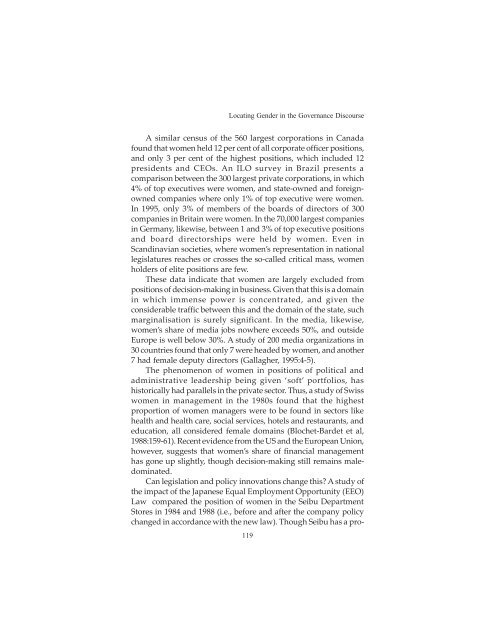Essays On Gender And Governance - United Nations Development ...
Essays On Gender And Governance - United Nations Development ...
Essays On Gender And Governance - United Nations Development ...
You also want an ePaper? Increase the reach of your titles
YUMPU automatically turns print PDFs into web optimized ePapers that Google loves.
Locating <strong>Gender</strong> in the <strong>Governance</strong> Discourse<br />
A similar census of the 560 largest corporations in Canada<br />
found that women held 12 per cent of all corporate officer positions,<br />
and only 3 per cent of the highest positions, which included 12<br />
presidents and CEOs. An ILO survey in Brazil presents a<br />
comparison between the 300 largest private corporations, in which<br />
4% of top executives were women, and state-owned and foreignowned<br />
companies where only 1% of top executive were women.<br />
In 1995, only 3% of members of the boards of directors of 300<br />
companies in Britain were women. In the 70,000 largest companies<br />
in Germany, likewise, between 1 and 3% of top executive positions<br />
and board directorships were held by women. Even in<br />
Scandinavian societies, where women’s representation in national<br />
legislatures reaches or crosses the so-called critical mass, women<br />
holders of elite positions are few.<br />
These data indicate that women are largely excluded from<br />
positions of decision-making in business. Given that this is a domain<br />
in which immense power is concentrated, and given the<br />
considerable traffic between this and the domain of the state, such<br />
marginalisation is surely significant. In the media, likewise,<br />
women’s share of media jobs nowhere exceeds 50%, and outside<br />
Europe is well below 30%. A study of 200 media organizations in<br />
30 countries found that only 7 were headed by women, and another<br />
7 had female deputy directors (Gallagher, 1995:4-5).<br />
The phenomenon of women in positions of political and<br />
administrative leadership being given ‘soft’ portfolios, has<br />
historically had parallels in the private sector. Thus, a study of Swiss<br />
women in management in the 1980s found that the highest<br />
proportion of women managers were to be found in sectors like<br />
health and health care, social services, hotels and restaurants, and<br />
education, all considered female domains (Blochet-Bardet et al,<br />
1988:159-61). Recent evidence from the US and the European Union,<br />
however, suggests that women’s share of financial management<br />
has gone up slightly, though decision-making still remains maledominated.<br />
Can legislation and policy innovations change this? A study of<br />
the impact of the Japanese Equal Employment Opportunity (EEO)<br />
Law compared the position of women in the Seibu Department<br />
Stores in 1984 and 1988 (i.e., before and after the company policy<br />
changed in accordance with the new law). Though Seibu has a pro-<br />
119

















